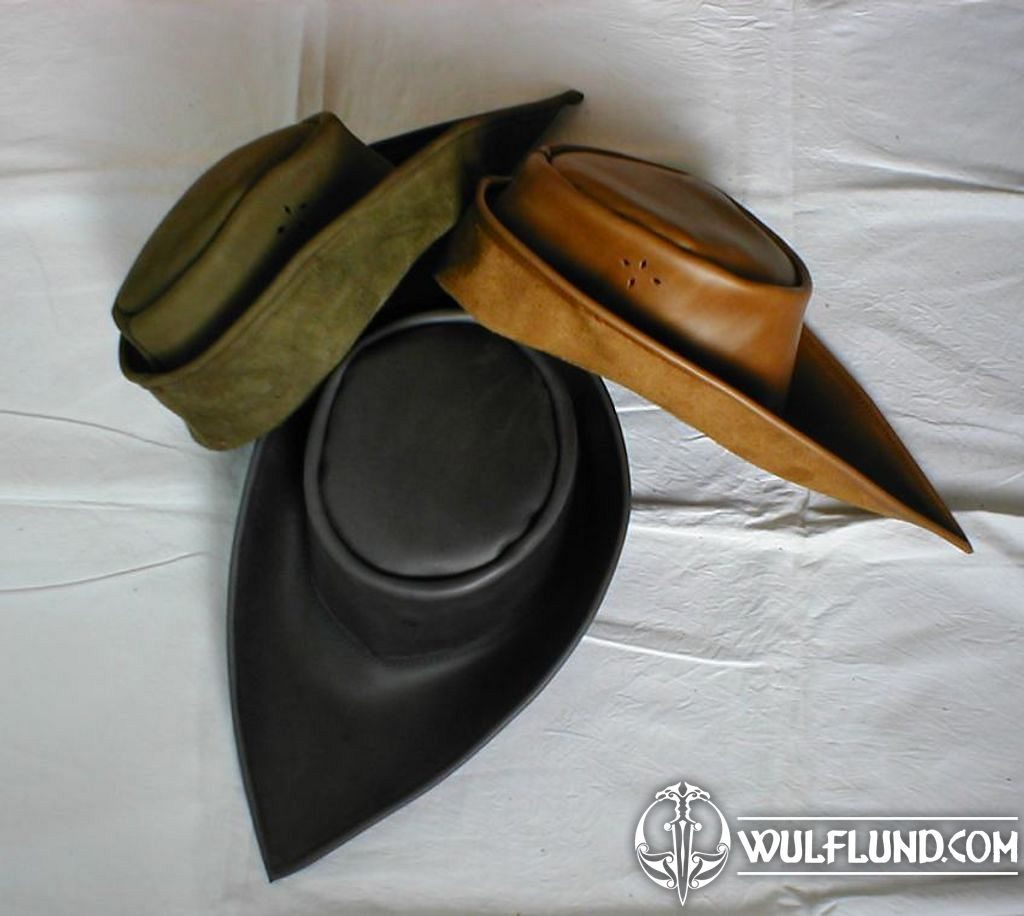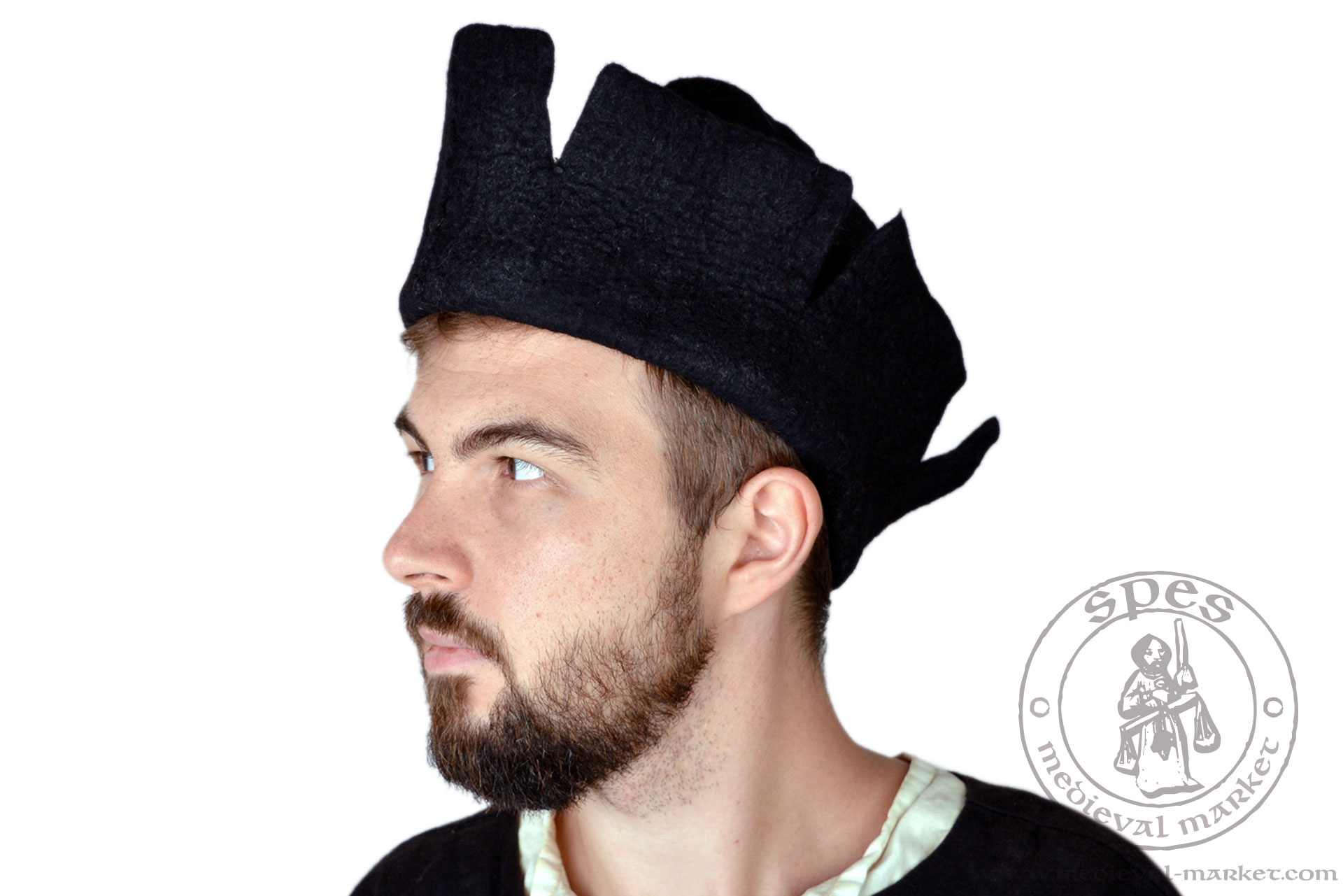
Cappello a punta detto a Becco Periodo Modello molto diffuso in Europa durante il 1300
Medieval fashion is the different clothing styles and trends that were worn by the people of Europe during the Middle Ages. The Middle Ages spans from the time when the Roman Empire collapsed in the west in 410 until roughly 1485 CE when the Renaissance began. Medieval fashion includes the garments, accessories, and overall aesthetic choices of.

that is a truly outstanding hat. HG Medieval hats, Medieval clothing, Medieval costume
During the Middle Ages, many different helmets, almost all made of metal, were developed. Among them are the spangenhelm, the great helm, the bascinet, and the frog-mouth helm, mostly for jousting tournaments.. This 11th-century helmet, known as Kettle Hat or War Hat (created earlier but most popularised around that time) had wide metal.

Medieval hat Medieval cap 14th century Medieval hats, Woolen cap, Woolen sweaters
Types of men's hats included wide-brimmed straw hats, close-fitting coifs of linen or hemp that tied under the chin like a bonnet, and a wide variety of felt, cloth or knitted caps. Women wore veils and wimples. Among the fashion-conscious nobility of the High Middle Ages, some fairly complex hats and head rolls for men and women were in vogue.

Living in the Current Middle Ages with the Society for Creative Anachronism (SCA) By Gregor
Headwear of the Middle Ages. People living in Europe during the long period of history known as the Middle Ages (c. 500 - c. 1500) wore a variety of different hairstyles and headwear. As with other elements of medieval costume, these styles were fairly simple up until about the twelfth century, when increasing wealth and changes in social life brought an upsurge in decoration, especially in.

MEDIEVAL LEATHER HAT
Article. As in just about any other period of history, clothing in the Middle Ages was worn for necessity, comfort, and display. Bright colours and rich decorations made for a striking medieval wardrobe, at least among the wealthy, although there was a surprising similarity in clothes for different social classes and the sexes.

Media preview Medieval fashion, Medieval hats, Medieval clothing
Symbolism and Knighthood. However, the kettle hat was more than just a functional piece of armor. It also carried profound symbolism and was a visible sign of a knight's status and bravery. Knighthood was a big deal in medieval society, you see. It represented honor, chivalry, and martial prowess.

Middle Ages hats. 12th to 15th century fashion history. World4Costume
Hats were an important part of medieval garb. Depending on one's occupation and the time of the year, hats could vary from linen head warmers, to straw or felt hats, to "borrelais" hats to fine mesh mail coifs, to "sallet" helmets, to visored "basinets" to mitres and crowns. Five hats are pictured below, try to determine which of the people.

MEDIEVAL HATS AND HEADDRESSES Pepper and Pine
Known as hennins, the tall headdresses were popular among European noblewomen in the late Middle Ages. Editor's Note, March 9, 2022: This article originally suggested that Mongolian headdresses.

Headwear list of goods. MEDIEVAL MARKET SPES.
Female headgear in the middle ages. Nobel headgear became quite elaborate during the period - we have all see the "princess hats" which were actually worn for a period of time. Some are very high, other very wide and some gives really different head shapes. Married women would generally always wear something on their heads when out in public.

Village Hat Shop Gallery Chapter 7 Medieval or Gothic Europe 52_G Medieval hats
We have many styles of hats from different eras. Surely you will find the perfect renaissance hat to add to your medieval wardrobe. We have cavalier hats, medieval hoods, renaissance hats, muffin hats, tricorns, snoods, Henry VIII hats, veils and much more. Most of our medieval hats you can select the size, color and even the fabric.

Medieval Hats, Medieval Clothes, Medieval Life, Medieval Dress, Medieval Period, Historical
A chaperon (/ ˈ ʃ æ p ər oʊ n / or / ˈ ʃ æ p ər ɒ n /; Middle French: chaperon) was a form of hood or, later, highly versatile hat worn in all parts of Western Europe in the Middle Ages.

Pin by Laurel Black on Medieval Hats and Headwear Medieval hats, Historical hats, Medieval costume
The middle ages, particularly the 14th and 15th centuries, were home to some of the most outstanding and gravity-defying headwear in history. Before the hennin rocketed skywards, padded rolls and truncated and reticulated headdresses graced the heads of fashionable ladies everywhere in Europe and England.

coiffe renaissance homme Medieval Hats, Medieval Clothes, Medieval Fashion, Historical Costume
Medieval Hats for Nobility. Nobility made use of different kinds of medieval hats which were worn on different occasions. Caps with a round crown and upstanding brim became popular during the reign of Richard I King of England from 1189 until his death in 1199.. The Chaperon was another popular medieval hood and later hat for nobles and became particularly popular during the 14th century.

Costumes/Accessories/Hats/Women's Hats/Women's Renaissance Headwear/Renaissance Halo with
Fifteenth-Century Headwear. Like many of the fashion trends of the fifteenth century, the headwear worn during the fifteenth century underwent a shift after about the 1470s. In the first part of the century, headwear and hairstyles generally followed the conventions of the late Middle Ages (c. 500 - c. 1500). Men tended to wear their hair in.

Lorenz Medieval Hat ubicaciondepersonas.cdmx.gob.mx
From simple close-fitting caps (coifs) to elaborations of folds, decorations, and fine materials, hats declared a man's place in the world. In Europe during the Middle Ages and Renaissance, a man's occupation, religion, and status could be immediately understood by his hat. In some cases, the law mandated the wearing of certain head coverings.

Pin on Ren.Medieval Hats,Headwear
Hats and other forms of headwear were worn throughout the Middle Ages.. By late in the Middle Ages, especially after the twelfth century, women's headwear became very elaborate. Two of the most dramatic headdresses were the steeple headdress, which was shaped like a tall dunce cap and adorned with a veil, and the ram's horn headdress, which.
- Dna By Dennis Kelly Characters
- Concrete Spurs For Fence Posts
- Nash Double Top 2 Man Bivvy
- Diy Replacement Conservatory Roof Kit
- Caravans For Sale Villamar Benidorm 2023
- 26 Inch Mountain Bike Rims
- Fire And Ice Durham 2023
- Peter Thomas Roth Water Drench Cloud Cream
- Miniature Fairies For Fairy Gardens
- Peugeot Expert Van Tyre Pressure